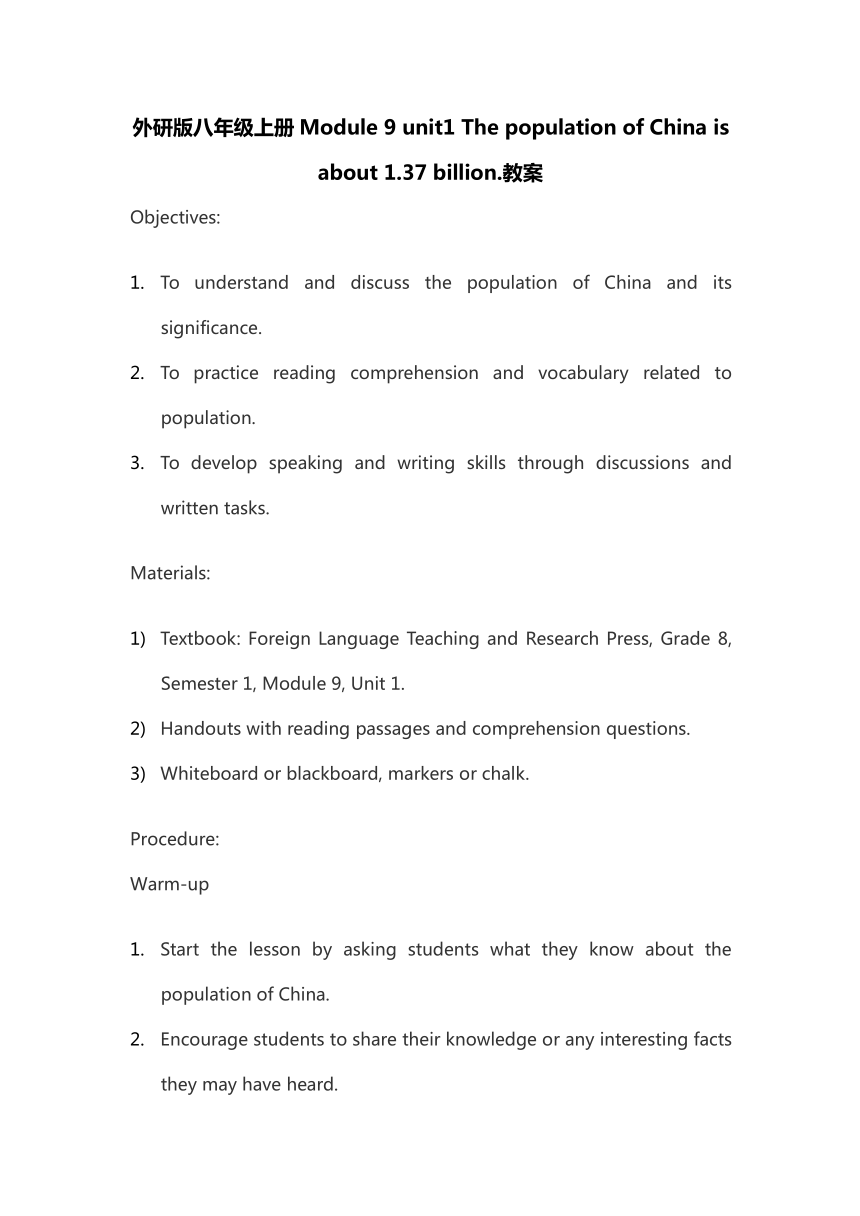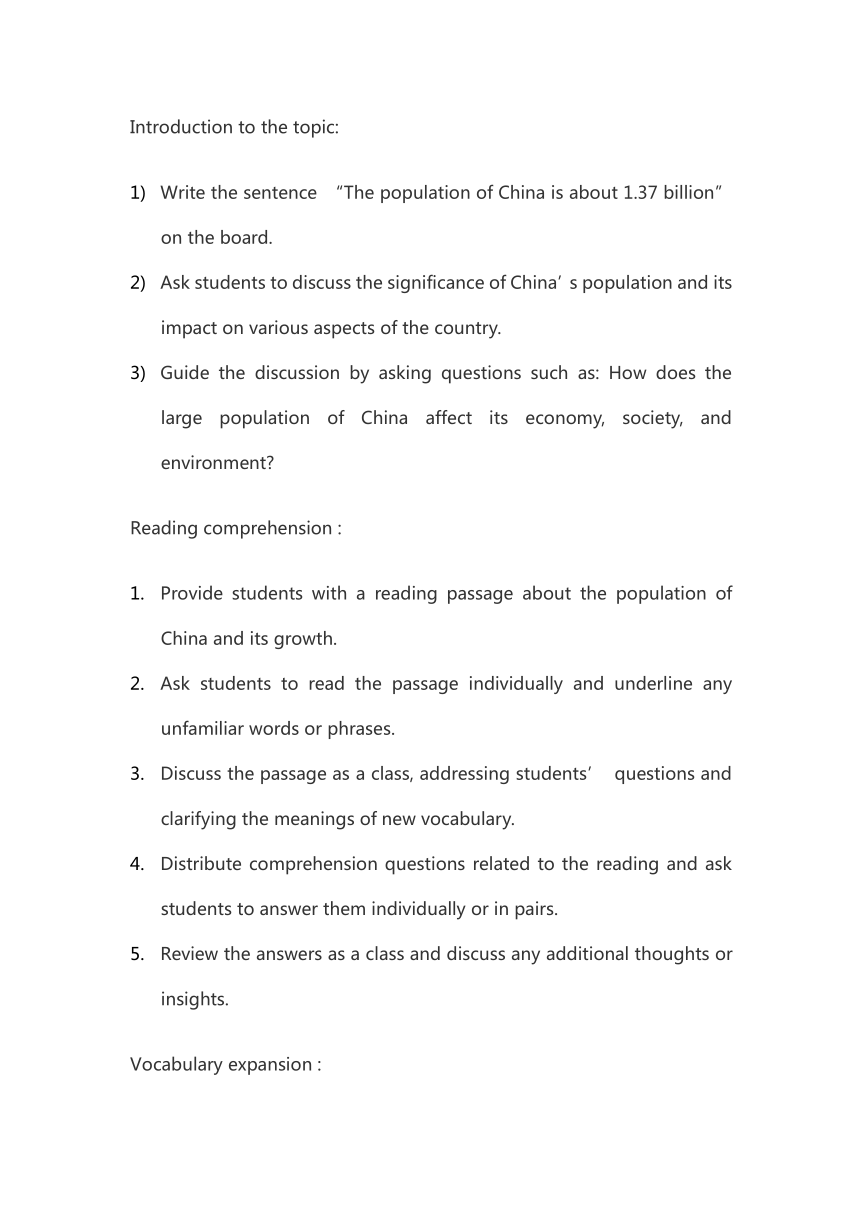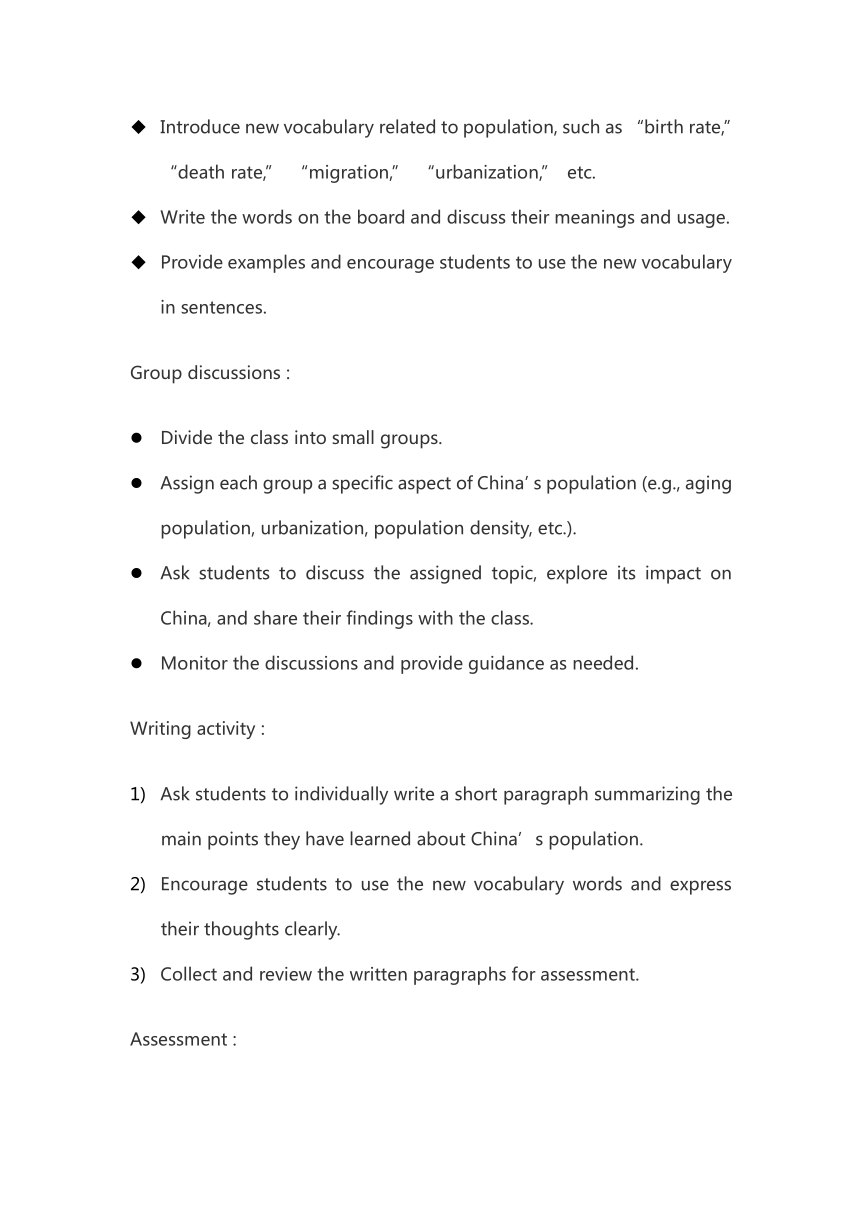外研版八年级上册Module 9 Population unit1 教案
文档属性
| 名称 | 外研版八年级上册Module 9 Population unit1 教案 |  | |
| 格式 | docx | ||
| 文件大小 | 19.0KB | ||
| 资源类型 | 教案 | ||
| 版本资源 | 外研版 | ||
| 科目 | 英语 | ||
| 更新时间 | 2023-08-03 08:53:42 | ||
图片预览



文档简介
外研版八年级上册Module 9 unit1 The population of China is about 1.37 billion.教案
Objectives:
To understand and discuss the population of China and its significance.
To practice reading comprehension and vocabulary related to population.
To develop speaking and writing skills through discussions and written tasks.
Materials:
Textbook: Foreign Language Teaching and Research Press, Grade 8, Semester 1, Module 9, Unit 1.
Handouts with reading passages and comprehension questions.
Whiteboard or blackboard, markers or chalk.
Procedure:
Warm-up
Start the lesson by asking students what they know about the population of China.
Encourage students to share their knowledge or any interesting facts they may have heard.
Introduction to the topic:
Write the sentence “The population of China is about 1.37 billion” on the board.
Ask students to discuss the significance of China’s population and its impact on various aspects of the country.
Guide the discussion by asking questions such as: How does the large population of China affect its economy, society, and environment
Reading comprehension :
Provide students with a reading passage about the population of China and its growth.
Ask students to read the passage individually and underline any unfamiliar words or phrases.
Discuss the passage as a class, addressing students’ questions and clarifying the meanings of new vocabulary.
Distribute comprehension questions related to the reading and ask students to answer them individually or in pairs.
Review the answers as a class and discuss any additional thoughts or insights.
Vocabulary expansion :
Introduce new vocabulary related to population, such as “birth rate,” “death rate,” “migration,” “urbanization,” etc.
Write the words on the board and discuss their meanings and usage.
Provide examples and encourage students to use the new vocabulary in sentences.
Group discussions :
Divide the class into small groups.
Assign each group a specific aspect of China’s population (e.g., aging population, urbanization, population density, etc.).
Ask students to discuss the assigned topic, explore its impact on China, and share their findings with the class.
Monitor the discussions and provide guidance as needed.
Writing activity :
Ask students to individually write a short paragraph summarizing the main points they have learned about China’s population.
Encourage students to use the new vocabulary words and express their thoughts clearly.
Collect and review the written paragraphs for assessment.
Assessment :
Observe students’ participation in group discussions and their ability to present information about the assigned topics.
Review and assess the written paragraphs based on their comprehension, vocabulary usage, and clarity of expression.
Closure:
Recap the main points discussed in the lesson, emphasizing the significance and impact of China’s population.
Encourage students to continue exploring and learning about population-related topics in their daily lives.
Summarize the importance of understanding population dynamics for a better understanding of global issues.
Extension Activities (optional, depending on available time and resources):
a. Research Project: Assign students a research project where they can explore the population trends and challenges in another country. They can present their findings in a PowerPoint presentation or a written report.
b. Debate: Divide the class into two teams and organize a debate on a related topic, such as “Is overpopulation a global crisis ” or “Should governments implement population control measures ” Encourage students to research and prepare arguments for their respective positions.
c. Guest Speaker: Invite a guest speaker, such as a demographer or a sociologist, to talk to the students about population dynamics and its impact on society. Students can prepare questions in advance and engage in a Q&A session with the speaker.
d. Creative Writing: Ask students to write a short story or create a comic strip that highlights the consequences of population growth or offers innovative solutions to population-related challenges.
Assessment and Evaluation:
Assess students’ understanding and participation throughout the lesson through observation, group discussions, and individual tasks.
Review and provide feedback on students’ written paragraphs summarizing the main points about China’s population.
Use rubrics or a scoring guide to assess students’ research projects, debates, or creative writing pieces, if applicable.
Follow-up and Homework:
Assign homework that reinforces the concepts learned in class, such as summarizing an article on population issues or discussing the topic with family members.
Encourage students to continue exploring the topic on their own and bring in any relevant news articles or research findings to share in the next class.
Conclusion:
Recap the key points covered in the lesson and emphasize the importance of understanding population dynamics in a global context.
Encourage students to reflect on how population growth and related challenges impact their own lives and communities.
Thank students for their participation and encourage them to continue learning and staying informed about population-related issues.
Objectives:
To understand and discuss the population of China and its significance.
To practice reading comprehension and vocabulary related to population.
To develop speaking and writing skills through discussions and written tasks.
Materials:
Textbook: Foreign Language Teaching and Research Press, Grade 8, Semester 1, Module 9, Unit 1.
Handouts with reading passages and comprehension questions.
Whiteboard or blackboard, markers or chalk.
Procedure:
Warm-up
Start the lesson by asking students what they know about the population of China.
Encourage students to share their knowledge or any interesting facts they may have heard.
Introduction to the topic:
Write the sentence “The population of China is about 1.37 billion” on the board.
Ask students to discuss the significance of China’s population and its impact on various aspects of the country.
Guide the discussion by asking questions such as: How does the large population of China affect its economy, society, and environment
Reading comprehension :
Provide students with a reading passage about the population of China and its growth.
Ask students to read the passage individually and underline any unfamiliar words or phrases.
Discuss the passage as a class, addressing students’ questions and clarifying the meanings of new vocabulary.
Distribute comprehension questions related to the reading and ask students to answer them individually or in pairs.
Review the answers as a class and discuss any additional thoughts or insights.
Vocabulary expansion :
Introduce new vocabulary related to population, such as “birth rate,” “death rate,” “migration,” “urbanization,” etc.
Write the words on the board and discuss their meanings and usage.
Provide examples and encourage students to use the new vocabulary in sentences.
Group discussions :
Divide the class into small groups.
Assign each group a specific aspect of China’s population (e.g., aging population, urbanization, population density, etc.).
Ask students to discuss the assigned topic, explore its impact on China, and share their findings with the class.
Monitor the discussions and provide guidance as needed.
Writing activity :
Ask students to individually write a short paragraph summarizing the main points they have learned about China’s population.
Encourage students to use the new vocabulary words and express their thoughts clearly.
Collect and review the written paragraphs for assessment.
Assessment :
Observe students’ participation in group discussions and their ability to present information about the assigned topics.
Review and assess the written paragraphs based on their comprehension, vocabulary usage, and clarity of expression.
Closure:
Recap the main points discussed in the lesson, emphasizing the significance and impact of China’s population.
Encourage students to continue exploring and learning about population-related topics in their daily lives.
Summarize the importance of understanding population dynamics for a better understanding of global issues.
Extension Activities (optional, depending on available time and resources):
a. Research Project: Assign students a research project where they can explore the population trends and challenges in another country. They can present their findings in a PowerPoint presentation or a written report.
b. Debate: Divide the class into two teams and organize a debate on a related topic, such as “Is overpopulation a global crisis ” or “Should governments implement population control measures ” Encourage students to research and prepare arguments for their respective positions.
c. Guest Speaker: Invite a guest speaker, such as a demographer or a sociologist, to talk to the students about population dynamics and its impact on society. Students can prepare questions in advance and engage in a Q&A session with the speaker.
d. Creative Writing: Ask students to write a short story or create a comic strip that highlights the consequences of population growth or offers innovative solutions to population-related challenges.
Assessment and Evaluation:
Assess students’ understanding and participation throughout the lesson through observation, group discussions, and individual tasks.
Review and provide feedback on students’ written paragraphs summarizing the main points about China’s population.
Use rubrics or a scoring guide to assess students’ research projects, debates, or creative writing pieces, if applicable.
Follow-up and Homework:
Assign homework that reinforces the concepts learned in class, such as summarizing an article on population issues or discussing the topic with family members.
Encourage students to continue exploring the topic on their own and bring in any relevant news articles or research findings to share in the next class.
Conclusion:
Recap the key points covered in the lesson and emphasize the importance of understanding population dynamics in a global context.
Encourage students to reflect on how population growth and related challenges impact their own lives and communities.
Thank students for their participation and encourage them to continue learning and staying informed about population-related issues.
同课章节目录
- Module 1 How to learn English
- Unit 1 Let's try to speak English as much as possi
- Unit 2 You should smile at her.
- Unit 3 Language in use .
- Module 2 My home town and my country
- Unit 1 It's taller than many other buildings.
- Unit 2 Cambridge is a beautiful city in the east o
- Unit 3 Language in use .
- Module 3 Sports.
- Unit 1 Nothing is more exciting than playing tenni
- Unit 2 This year we training more carefully.
- Unit 3 Language in use .
- Module 4 Planes, ships and trains .
- Unit 1 He lives the farthest from school.
- Unit 2 What is the best way to travel.
- Unit 3 Language in use .
- Module 5 Lao She Teahouse.
- Unit 1 I wanted to see the Beijing Opera.
- Unit 2 It descibes the changes in Chinese society.
- Unit 3 Language in use .
- Module 6 Animals in danger.
- Unit 1 It allows people to get closer to them .
- Unit 2 The WWF is working hard to save them all.
- Unit 3 Language in use .
- Revision module A
- Module 7 A famous story
- Unit 1 Alice was sitting with her sister by the ri
- Unit 2 She was thinking about her cat.
- Unit 3 Language in use .
- Module 8 Accidents
- Unit 1 While the car were changing to red, a car s
- Unit 2 I was trying to pick it up when it bite me
- Unit 3 Language in use .
- Module 9 Population
- Unit 1 The population of China is about 1.37 billi
- Unit 2 Arnwick was a city with 200,000 people.
- Unit 3 Language in use .
- Module 10 The weathe
- Unit 1 It might snow.
- Unit 2 The weather is fine all year round.
- Unit 3 Language in use .
- Module 11 Way of life
- Unit 1 In China ,we open a gift later.
- Unit 2 In England, you usually drink tea with milk
- Unit 3 Language in use .
- Module 12 Help
- Unit 1 What should we do before help arrives?
- Unit 2 Stay away from windows and heavy furniture.
- Unit 3 Language in use .
- Revision module B
